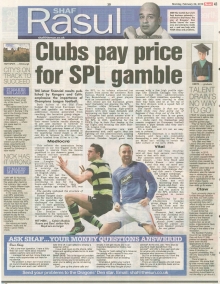The latest financial results published by Rangers and Celtic emphasise the importance of Champions League football.
Both halves of the Old Firm budget for top level European football and gamble on receiving the additional income generated from reaching the lucrative group stages.
Rangers’ qualification to Europe’s premier competition was reflected in their recent interim results showing a 40 per cent increase in turnover to £37.8million and profits of £13.1m compared to their previous losses of £3.9m.
However, Celtic’s defeat to Arsenal in the qualifying round meant a 23 per cent dip in turnover to £36.11m… and profits crashed from £8.5m to £1.5m.
This reflects the constraints being imposed on our two biggest clubs who struggle to operate from the income generated in our domestic game.
Despite sell-out crowds, domestic dominance and even Champions League qualification, neither are able to outstrip the revenues of mediocre English clubs.
But it’s not just the Old Firm who are struggling. Scottish football is continuing to pay for the boom-and-bust strategy they took a decade ago when the SPL was created.
The gamble reshaped the structure of Scottish football.
Former Rangers chairman Sir David Murray led the spending and challenged the smaller clubs to start gambling on expensive foreign talent to gain success.
The smaller clubs responded to his ‘speculate to accumulate’ strategy and the SPL in its infancy attracted top players from across the continent.
Rino Gattuso, Henrik Larsson and Giovanni Van Bronckhorst – all great players with an international pedigree.
But where are the European greats now? Certainly not gracing the SPL.
Smaller clubs followed the Old Firm’s example, buying high-profile players with silly wage demands and borrowing on their assets to do so.
Livingston had quick success after a spending spree, winning promotion to the SPL in 2001, qualifying for the UEFA Cup in their first season in the top flight, and winning the 2004 Scottish League Cup.
But their struggles are well documented and, once again, they are fighting off the administrators, playing their football in Scotland’s third division.
Dundee forged great early success with a few high profile signings like Claudio Caniggia but they were forced into administration because of their relentless spending – they are only now starting to claw their way back and sit at the top of the first division with a squad full of homegrown players.
The harsh reality is that our top flight clubs now face going out of business if they drop out of the SPL.
The money is not there in our game, which prevents the real talent coming in – clubs can’t fix themselves and remain stagnant so European football becomes a pipe dream and they can’t service their debt.
It’s a cycle – and it’s not an easy one to reverse.
Aberdeen’s chairman is a multi-millionaire and fans are constantly demanding a cash injection but Stewart Milne isn’t willing to revisit the debt culture of the early 2000s.
Walter Smith and Tony Mowbray sold off their high earners, sacrificing talent to deal with debt.
But common sense dictates that the best players – like Kris Boyd and Robbie Keane – win games and this was no more evident in the majority of Rangers performances during this year’s Champions League campaign.
Scottish football is now at a crossroads.
Clubs are still recovering from the boom-and-bust era of a decade ago and the quality of the SPL product has struggled in recent years.
Qualifying for the Champions League group stages is vital for the Old Firm and the general health of Scottish football.
However, last week’s news that Scotland will lose one of its two Champions League places from season 2011/12 paints an even bleaker picture for our game.
| Related Content: UK Richlist Property Investment Strategies Revealed |

